Walking with Emily Ash Powell, hurdler
The global head of copy on leaping over life’s hurdles and why everyone is interesting when you’re interested
“Being a copywriter is like being an actor – you’re taking on a character, all their personality traits and their big worlds of language.”
Hello walkers and writers 👋
There are some people in life who sweep you away with their enthusiasm and joy from the moment you meet them. Emily Ash Powell is one of those people. We met almost ten years ago at a #CopywritersUnite night in London, organised by the fabulous Vikki Ross, and immediately bonded over words, wine and a love of doggos.
Since then, I’ve seen Em go from strength to strength, writing her way up the ladder from junior creative roles to becoming the global head of creative and copy for brands like Tony’s Chocolonely and Bumble. Along the way, she’s drop-kicked the barriers in her path and used her power with words to talk openly about issues that many people might be afraid to approach – all while sending a blast of positivity and joy out into the world along the way.
We’ve chatted about doing something together for ages, so we finally got together for a waddle along the Regent’s canal in London where we talked about being working class but hiding our accents to fit in, overcoming career hurdles, and – the most important topic of all, so maybe I should have just led with it: crisps.
We’ve loved putting this interview together for you and hope you enjoy it.
Hiya Em, lovely to catch up with you. We’ve known each other for yonks, so for the benefit of our readers, please introduce yourself
Hiya. My name’s Emily (though most people call me Em, unless I’m in trouble) and I’m a Welsh writer. I’m currently Global Head of Copy & Editorial at Bumble by day, and a writer for other brands, publications and my Substack, Hurdling, by night and other corners of the day. I live in North London with my husband, who is my favourite person ever.
My writing career started at the age of 7, when I had a poem published in the Donkey Sanctuary magazine. This is when I peaked. After that, I found myself only really caring about the subjects in school that revolved around writing, music, language and using my imagination. That led to a degree in English Literature, Language & Creative Writing at Swansea University, which led to an existential crisis about how on earth I was going to find a job that would let me move to London and do the things I was good at (and most importantly, interested in) while still having fun.
After what felt like hundreds of applications and rejections later, I finally had a call from a recruiter about a Social Media Editor role. It was an early stage subscription startup that made and sold personalised dog food on the internet called tails.com. Somehow, with no experience and only enthusiasm, I got the job. At that role, I spent two years inhaling everything I could possibly learn and try in the world of brand, marketing and creative. In addition to running the social media channels, writing articles and creating content, I started writing all the words for the website, emails, inbox comms and packaging, and discovered that this was called ‘copywriting’.
Once I had a little taste of this life as a ‘real’ writer, it was all I wanted. I spent the very little money I had (£21k a year with £900 rent for a room in London doesn’t leave much spare change in your pocket) on workshops and courses and events, and threw myself into the creative world, figuring out how I could actually convince my boss (the Chief Marketing Officer) to let me leave social media behind and become a full-time word merchant in the creative team. I met Vikki Ross after her D&AD workshop on copy and tone of voice and stayed behind to help her clear up the pizza boxes (only the best writing workshops have pizza, you see). I introduced myself and explained my situation and asked if she mentored any writers and she said that she did, but that she was fully booked at the moment. Slightly dejected, but nevertheless persistent, I asked if we could swap emails and if she could email me if a slot ever freed up.
For some reason, Vikki decided to make space and time and energy for me, and over the course of a few hour-long sessions, she helped me form a plan to convince my boss to let me formalise the fact that I was writing all the copy for the brand, and add ‘Copywriter’ into my title. I pitched the role, like we’d practiced, and was met with a simple, ‘What makes you think you’re a writer?’ I was speechless. I was 23 and couldn’t understand why one minute she’d be praising all my words, asking me to write more, then the next hitting me with this? Now that I’m older, I have a few more theories as to why.
I left that meeting in tears and replied to Vikki’s ‘How did it go?’ message with a spluttering phone call. She asked me what I wanted more, to work at the startup that I so dearly loved, or to become a writer? I chose the latter, pulled together a portfolio, applied for every copywriter job I could see on LinkedIn and eventually accepted one as European Copywriter for a fintech company. Finally, I was a writer and no one could tell me I wasn’t. I’ve been writing ever since.
“My writing career started at the age of 7, when I had a poem published in the Donkey Sanctuary magazine.”
Blimey, that’s a lot of hurdles to get over. Is that what eventually led you to launching Hurdling, your Substack about how we get over the things that stand in our way?
I started Hurdling back in 2022 because I got so fed up of reading people’s ‘success’ stories, where they only really talked about what happened after they cleared their hurdles – glossing over all the blood, sweat and tears that actually got them over it in the first place. I remember seeing someone online tell their story of having such bad burnout that they took a year off work, then re-emerged having written a memoir, which got published and immediately hit the charts. But I wanted to know how exactly they did that? How did they afford to do that? What were all the practical hoops they had to jump through? Like, literally how did you do that?
I wanted to create a space where I could take a good look at (and even celebrate) the hurdles that so many of us face in all the corners of our lives. I wanted to ask questions and find answers – not just for me, but for others, too. I wanted to interview people from all walks of life (not just all the regular famous guests who do all the podcast rounds) and show that every single person has a story and everyone is interesting if you’re interested enough in finding out why.
Now, it’s a place to peek behind the scenes of the highlights reels we all produce for our lives. It’s somewhere where I can reflect on the messy bits, the things gone wrong, the lessons we have to learn and to share real stories, honest thoughts and unfiltered reflections from myself, and other brilliant people, too. Some of my favourite interviews include Simon Thompson, a Botanical Horticulturist at Kew Gardens, Lo Constantinou, the founder of the CV writing agency, Good Copyand Dave Buonaguidi, the artist and printmaker (who you probably know better as Real Hackney Dave). They’re all so wildly different, and that’s the whole point. Everyone is interesting if you’re interested.
I pulled together a portfolio, applied for every copywriter job I could see on LinkedIn and accepted one as European Copywriter for a fintech company. Finally, I was a writer and no one could tell me I wasn’t.”
Has anything unexpected happened for you as a result of writing Hurdling?
It’s made me feel a lot more confident in writing in my own voice. When you’re the voice behind the brand, it’s pretty daunting to hold your hand up and say in a tiny voice, ‘Hi I actually have my own voice and I have something I’d like to say!’ But if you know me, you’ll know that I pretty much always have something (too much, usually) to say. It just took me a long time to pluck up the courage to publish it myself.
That knock from the CMO I told you about earlier impacted my confidence for a very long time. But somewhere along the way, it turned into fuel to say, ‘What makes me think I’m a writer? I’ll show you right now.’ I’d started pitching articles to magazines and publications, and used holiday days to take time off work to do an unpaid internship at the Sunday Times Style, so that I could find out how it all actually worked, and what editors wanted from writers. I got a few bylines at Stylistfor reviewing books (though this was unpaid, btw!) and that led to a commission from Refinery29 and then more from HuffPost, Cosmopolitan, Metro, the i Paper and a few others, too.
But for every piece published, there’s probably 50 rejected (or unanswered) pitches. Hurdling has allowed me to have somewhere to write these things anyway, and somewhere to continuously figure out my own writing style.
Someone recently left a comment on one of my pieces that said, ‘Everything you write is so you.’ Until I read that, I don’t think I’d realised just how much it mattered to me that I could show up as myself and not only just be tolerated for it, but appreciated for it. Having spent a lot of my life being made to feel like I’m too loud, too talkative and too much, I don’t think there could be a bigger compliment. Hurdling has given me a tiny (orange) space to really feel like myself again.
“When you’re the voice behind the brand, it’s pretty daunting to hold your hand up and say in a tiny voice, ‘Hi I actually have my own voice and I have something I’d like to say!’”
You’re from Wales and now live in London – and as someone from Yorkshire who came to London I know how the cultural and class differences can feel overwhelming. Have you ever felt imposter syndrome or found yourself changing things about yourself to try and fit in? Like how you present yourself through your voice, accent and identity?
Oh my god, yes. This is something I’ve wrangled with from the moment I landed in London, and I recently wrote about losing (and re-finding) my accent. It is all so overwhelming and so confusing. I can remember being at work drinks, and a guy from the marketing team asked me which school I’d gone to. I’d excitedly replied with, ‘Archbishop McGrath School in Bridgend! Why, do you know it?!’, not understanding that what he was actually asking was whether I’d been to one of the well-known private schools in England. Needless to say, he had not heard of my school.
After a while, I began to realise there was this secret language of privilege and access that was spoken in startups, advertising agencies and tech companies – but it was never really spoken in a Welsh accent. I’d get comments about my Welsh accent all the time, would smile through the usual jokes that implied that Welsh people were all stupid, and accepted that being ‘exposed’ as Welsh was essentially an admission that I was not really supposed to be in the places I’d worked really fucking hard to be in, and somewhere along the way, I gradually heard my accent slip away. Now, it makes my heart ache when people tell me I ‘don’t really sound that Welsh anymore’.
But when I moved from London to Amsterdam (for just under a year for a maternity contract as Head of Creative at Tony’s Chocolonely), all of that changed. My husband and I upped and left our life in London (prompted by some pretty horrendous bullying and emotional abuse from his parents, who are no longer part of our life) and we sought to unravel all the things that made us feel like we couldn’t show up as ourselves.
I picked up the pieces of my shattered confidence, and unravelled a significant amount of tangled opinions about myself that had never belonged to me in the first place. I stopped doing the things I thought I should be doing. I started doing the things I wanted to be doing. And over time, I heard my accent start to come back.
It was like a fresh start with a blank canvas of a city on which to re-paint ourselves again, and I found that with a community of expats and without such an obvious privilege and class divide, my accent came back and I was able to my Welshness more than I’d ever felt able to in London. When we came back, I was determined to never let anyone make me feel like I needed to lose it again.
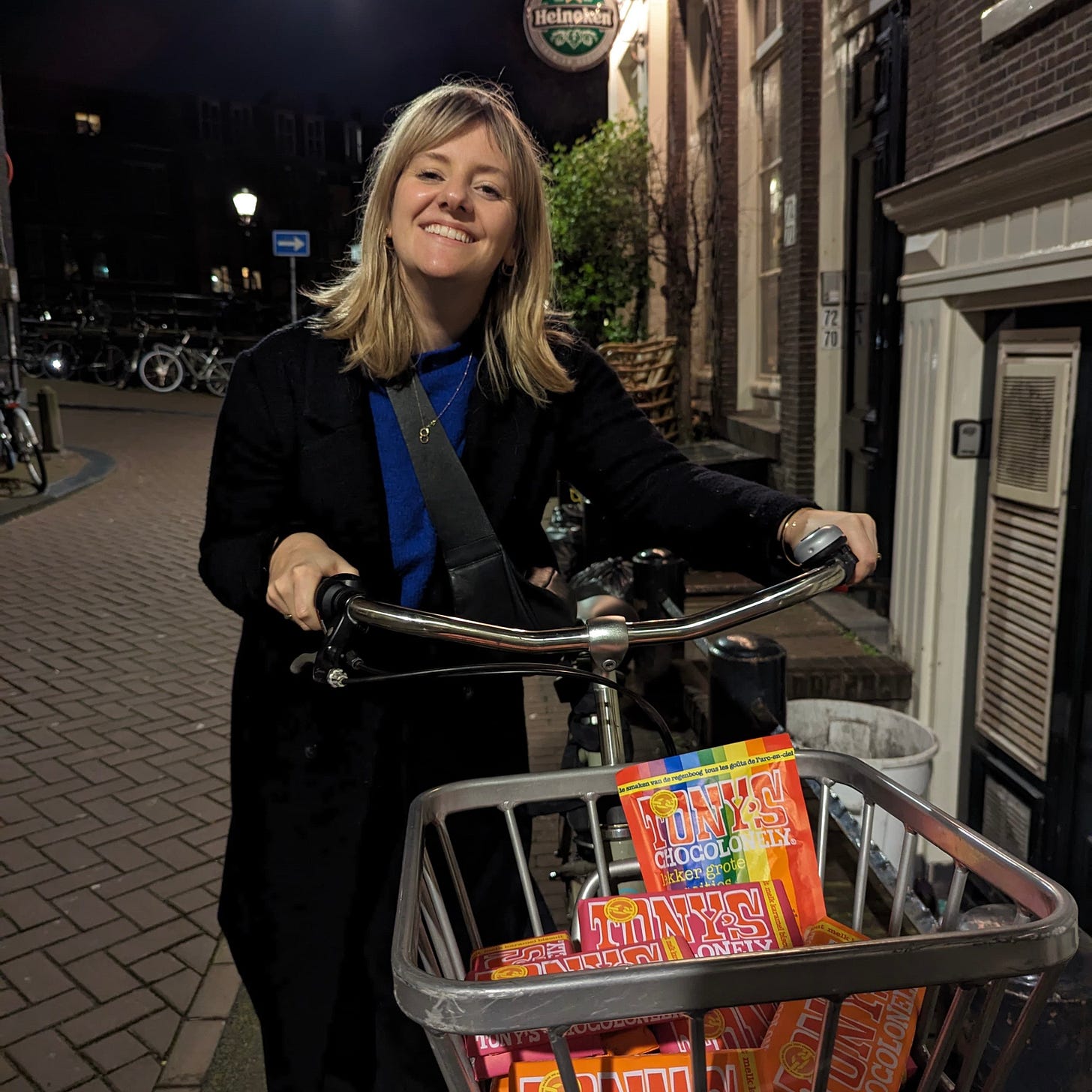
How did all of that make you feel?
I felt so sad and angry that I’d ever let anyone make me feel like I wasn’t enough! Enough for who? For someone who I didn’t care about anyway? I’ve now learned instead to try to be enough for me and for the people I care about. It takes a lot to unlearn the people-pleasing tendencies, and don’t get me wrong, I still spend the majority of my days wracked with self-doubt. But I am now so much sure of who I am, how I show up and what I can bring to rooms, people and my work.
As I’m sure you’ll know too, when you have an accent that’s not like everyone else’s in the rooms you’re in, you do draw attention to yourself. And it’s not always for the right reasons – people will always make the joke and do the impressions. But I don’t want to stand out for being the only Welsh person in the room. I want to stand out for being good at what I do. For being good at what I do, as well as being Welsh, instead of for being good at what I do, in spite of being Welsh. I used to feel it was the latter, but I’m determined to prove that it’s really not.
As a writer, your job is to help brands bring their voices to life. Do you think the chameleon effect – the tendency to mimic or mirror another person's facial expressions, nonverbal behaviours and verbal expressions – has given you an advantage?
I have never thought about it in that way before, but absolutely. I give different accents and speech rhythms to different brand voices and I read my copy out loud in those accents (my colleagues are very grateful for remote working, I’m sure). I always say that being a copywriter is like being an actor – you’re taking on a character, all their personality traits and their big worlds of language.
I think you’re right – the chameleon effect is definitely an advantage, but I would say that empathy is too. I am a huge overthinker and very curious and interested about other people and what they do and why they do it. I think writing for brands is ultimately about understanding what makes people tick, and speaking directly to them in the way that makes them feel understood.
“I give different accents and speech rhythms to different brand voices and I read my copy out loud in those accents.”
You’ve written for lots of amazing brands, but I know that writing for Skin + Me was a turning point. How did that come about?
Thank you, I feel so fortunate to have had the experiences I’ve had. With Skin + Me, I’d been invited to a focus group of women in their 20s by an ex-colleague from tails.com. A lot of the brains behind tails.com had also been behind graze.com and Innocent Drinks, and Skin + Me was to be the new brand on the block revolutionising another industry via subscription. At this point, there was no factory, no brand, no product and no name. So I went to the office in Soho to share insights on how I, a young woman who represented the target market, shopped skincare and felt about my skin.
After the session, I noticed a whiteboard on the wall of the office with a list of roles to hire. On that list was ‘Copyrighter’. On my way out, I grabbed a pen, circled the mis-spelled word and wrote ‘call me’ with my name, number and email underneath. They did and I pitched myself for the interview and got the job.
For the next few months, I had the job of a lifetime where I got to create a brand personality from scratch and create a tone of voice that truly spoke to our audience. It won a Women in Marketing Award a year or so later and it is still probably the piece of work I’m the most proud of. Not because of the award, but because of the emails we got from customers who said, ‘I finally feel seen’ because of the writing across the signup flow, packaging and emails.
From there, it sort of got me known as ‘the subscription startup writer’ and it led me to projects with Lick, Freddie’s Flowers and more. I don’t know that I’ll ever get another experience like that again, but it really was one of the best opportunities I’ve had as a brand writer.
“Creating Skin + Me’s brand personality and tone of voice is the work I’m most proud of because of emails from customers who said, ‘I finally feel seen’ because of the writing across the signup flow, packaging and emails.”
You’ve done a few side gigs and I love the ‘I Want To Eat Crisps With You’ print that you created with artist, Dave Buonaguidi. How did that come to life?
Ah, my pride and joy! I’d been a huge fan of Dave Buonaguidi’s work for a long time – good words written, fun moments captured and big, bold statements. I met him the Affordable Art Fair back in 2021 and I bought his ‘Party Like It’s 1999’ print (and I got to put the glitter on myself). He had an ‘I Want To Eat Biscuits With You’ print for sale and I said ‘Dave, everyone knows that crisps are far more superior than biscuits’ and he said ‘Fuck! I love crisps too!’ and I said ‘Can we do a ‘I Want To Eat Crisps With You’ one?’ and he said ‘Yeah!’
We turned them into different colours; red for ready salted, blue for cheese & onion, green for salt & vinegar and pink for prawn cocktail. All of them are on my kitchen wall and a few of my nearest and dearest friends have some copies too. It’s always fun to see your words in print, but even better to see them on a wall.
Let’s settle this debate: Crisps in sandwiches – yes or no?
Absolutely yes, but there are many conditions and caveats. At my wedding, we made little brown bags of crisp sandwich ingredients for everyone. In the bag was a bread roll, a small square of Welsh butter, a knife and a bag of crisps. I’d done this big Tesco order with pretty much at least one of every crisp available. But not all crisps are created equally as suitable for a sandwich. I felt sorry for those who had Wotsit sandwiches. Basically anything that’s got a maize base instead of a potato is wrong and doesn’t belong in the crisp sandwich. Walkers or Tayto are always the best.
For me, the ultimate crisp sandwich is made of:
1 bag of Cheese & Onion Walkers crisps
2 slices of Hovis Best of Both bread
Too much Lurpak butter
A handprint from where you’ve squished the bread with your hand, making sure all those crisps crumble into the smallest possible pieces
It also has to be cut into triangles, like a meal deal sandwich. This gives you more filling. I don’t know how this is true but it is.
“At my wedding, we made little brown bags of crisp sandwich ingredients for everyone. In the bag was a bread roll, a small square of Welsh butter, a knife and a bag of crisps. I felt sorry for those who had Wotsit sandwiches.”
What’s your walking style?
Happy Hiker
Reluctant Rambler
Sunday Stroller
Wild Weekender
Sarah, I know you are the queen of walking so please don’t hate me but I am absolutely a Reluctant Rambler.1 I find it really hard to do things (tasks, activities, work) that feel like they don’t have an objective or a purpose. I find it so hard to convince myself that the purpose of a walk is simply… to walk. I also tend to go everywhere on my bike, which puts me in the wheels, not heels club.
That said, once I’m actually over the hurdle of getting out of the house to go for the walk that I know will get me out of my own head, give me a dose of creativity or refresh my tired brain, I would probably say that I am a Wide-Eyed Waddler. I am basically a Welsh Corgi, waddling about on my short legs and gazing at everything around me with my mouth open, smiling at everyone I pass and peeking through windows and inventing backstories for the people who live in the living rooms I can see.
“I tend to go everywhere on my bike, which puts me in the wheels, not heels club.”
Headphones or head in the clouds?
If I need clarity, my head is in the clouds (and I am in my own head). If I need a reset or to get out of a funk, it’s music. If I need to be inspired or distracted, it’s a podcast. If I’m walking home alone at night and it feels a bit sketchy (hello, being a woman), I’ll have headphones in but nothing playing, though I do have this huge delusion that no one is going to murder me while I’m listening to Fearless by Taylor Swift. Like imagine being murdered while that song is playing in your ears? That would be ridiculous and embarrassing for the murderer.
My husband and I are obsessed with The Rest Is History podcast. The Titanic is my Roman Empire (as a child, I used to stand over the bannister of the staircase at my mum’s house and drop a necklace over the side like Rose does in the film, LOL) and I just loved the episodes where they brought to life all the stories and backgrounds of the passengers who weren’t famous or ‘of note’, and dive into their backgrounds and realities. It was fascinating. My other favourite podcast is Sentimental Garbage, with the author Caroline O’Donoghue, where she looks at the culture we love that society can sometimes make us feel ashamed of. It’s just gorgeous and funny and silly and wonderful.
“I have this huge delusion that no one is going to murder me while I’m listening to Fearless by Taylor Swift. Like imagine being murdered while that song is playing in your ears? That would be ridiculous and embarrassing for the murderer.”
Tell me about the most memorable walk you’ve ever done
My most memorable walk was on Wiseman’s Bridge beach in Pembrokeshire. It was New Year’s Eve, it was raining and my poor husband had to spend the entire morning trying to convince me to go for a walk with him (I told you I was a Reluctant Rambler). When we finally got to the beach, the tide was in so he suggested we go to the pub instead, then walk after. We sat at that pub for hours drinking pints and eating crisps until the tide was finally back out far enough to walk across the sand, across the bay to Saundersfoot. Not too far into the walk, he got down on one knee and asked me to marry him. On the sand, in the rain, full of crisps. Everyone says their wedding day is the best day of their life but this one was mine.
If you could take a walk with anyone, real or fictional, alive or gone, who would it be? And why?
I would always take a walk with my grandparents. I’m very lucky to be 31 and to have all four grandparents still with me. I love spending time with them and hearing all their stories (no matter how many times I’ve heard them before) and asking them more questions about their lives, decisions and opinions on the world. They always have the answers, and the ability to help me figure out my own, too.
One word round
One thing you always take with you on a walk? Hula Hoops.
One word to describe how you feel about writing? Painstaking (emphasis on the ‘pain’).
One flavour of crisps you can’t live without? Salt & Vinegar (specifically, the Sea Salt & Chardonnay Vinegar from the Co-Op).
Last question: please can you share a walking-inspired writing prompt for our readers?
Describe everything about a walk, from the point of view of the insole in your left shoe.
Em, that has to be the most specific, most niche writing prompt we’ve had so far on The Writer’s Walk. I love it! Thanks for walking with me and for being so generous with your answers to all my questions.
You can learn more about Em and her work on her website and follow her on Instagram. And you should definitely subscribe to her Substack, Hurdling:
I’ll leave you with this final thought from Em on copywriting, which is also a pretty good way to approach life:
“Writing for brands is ultimately about understanding what makes people tick, and speaking directly to them in the way that makes them feel understood.”
Happy walking and writing until next time.
Sarah
Em would go on to disprove this theory during our most enjoyable waddle along the Regent’s canal


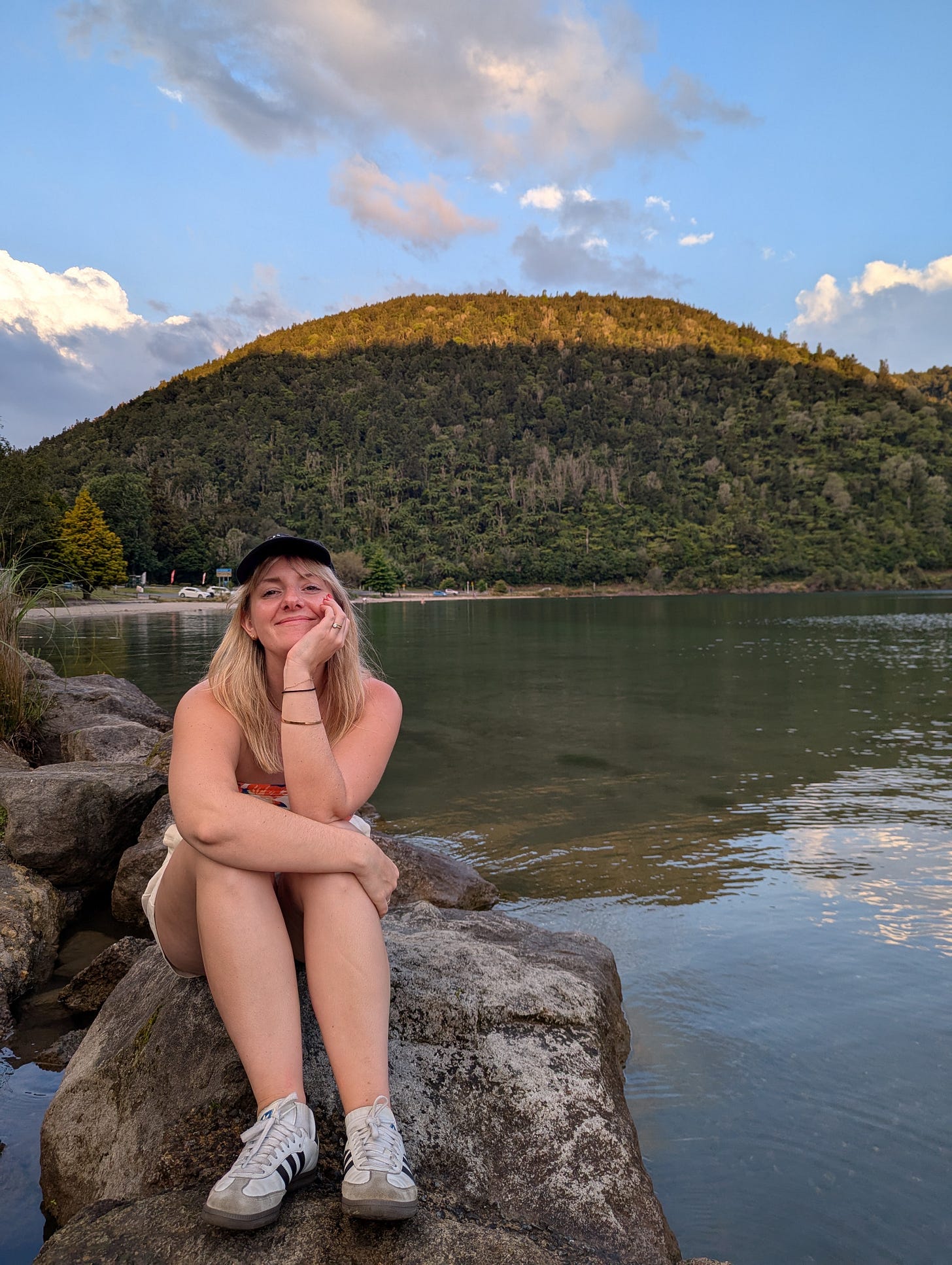
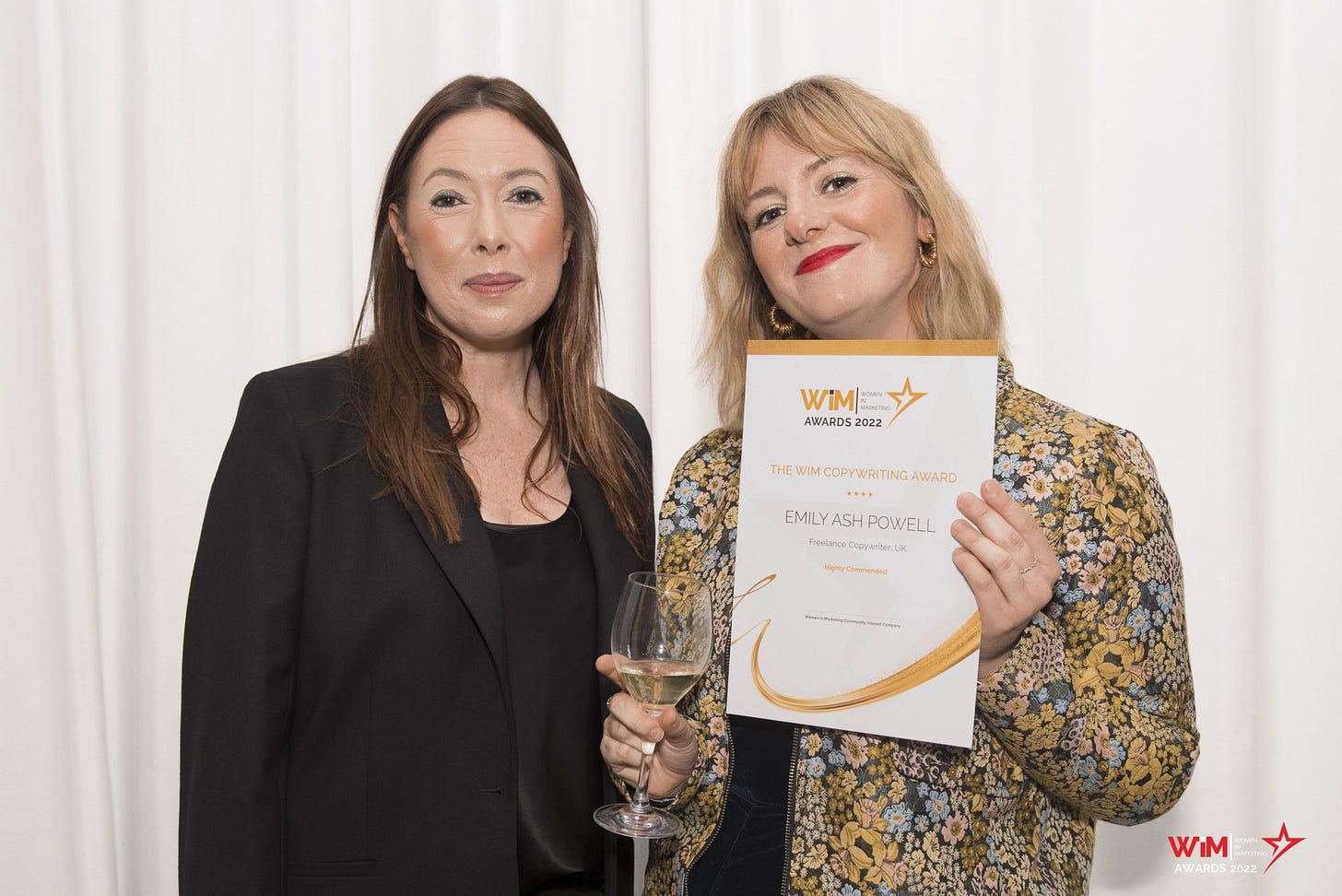
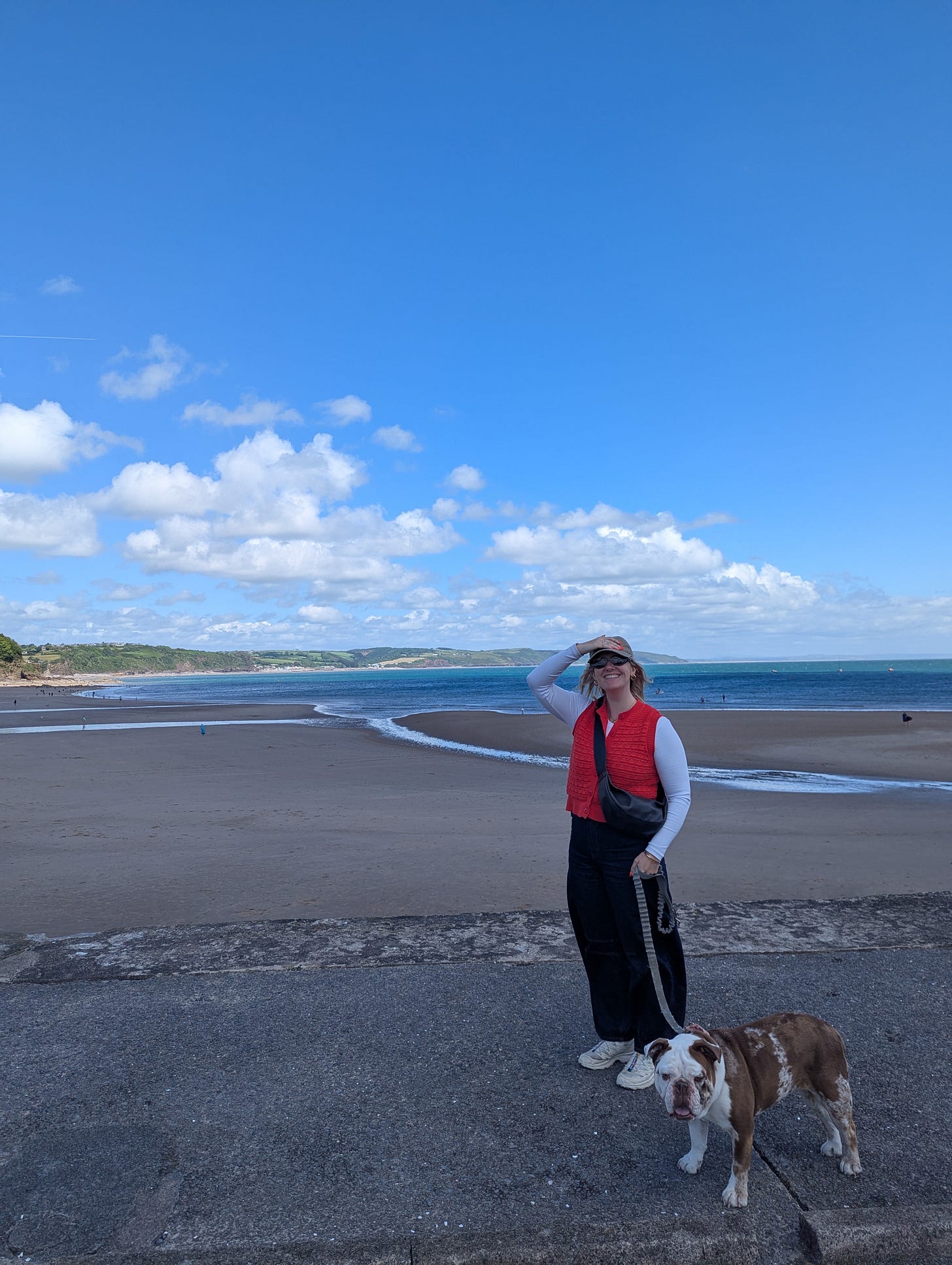

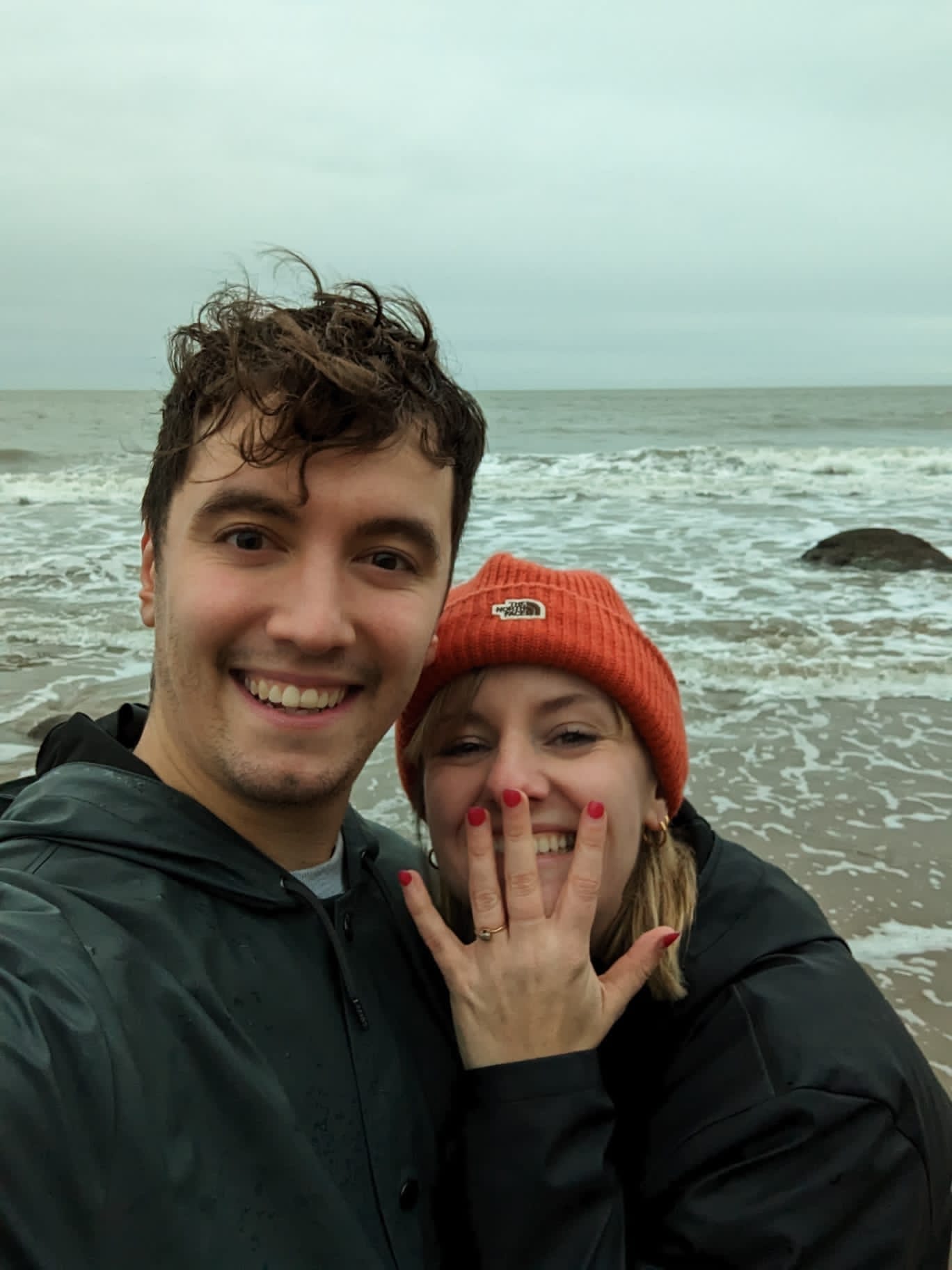
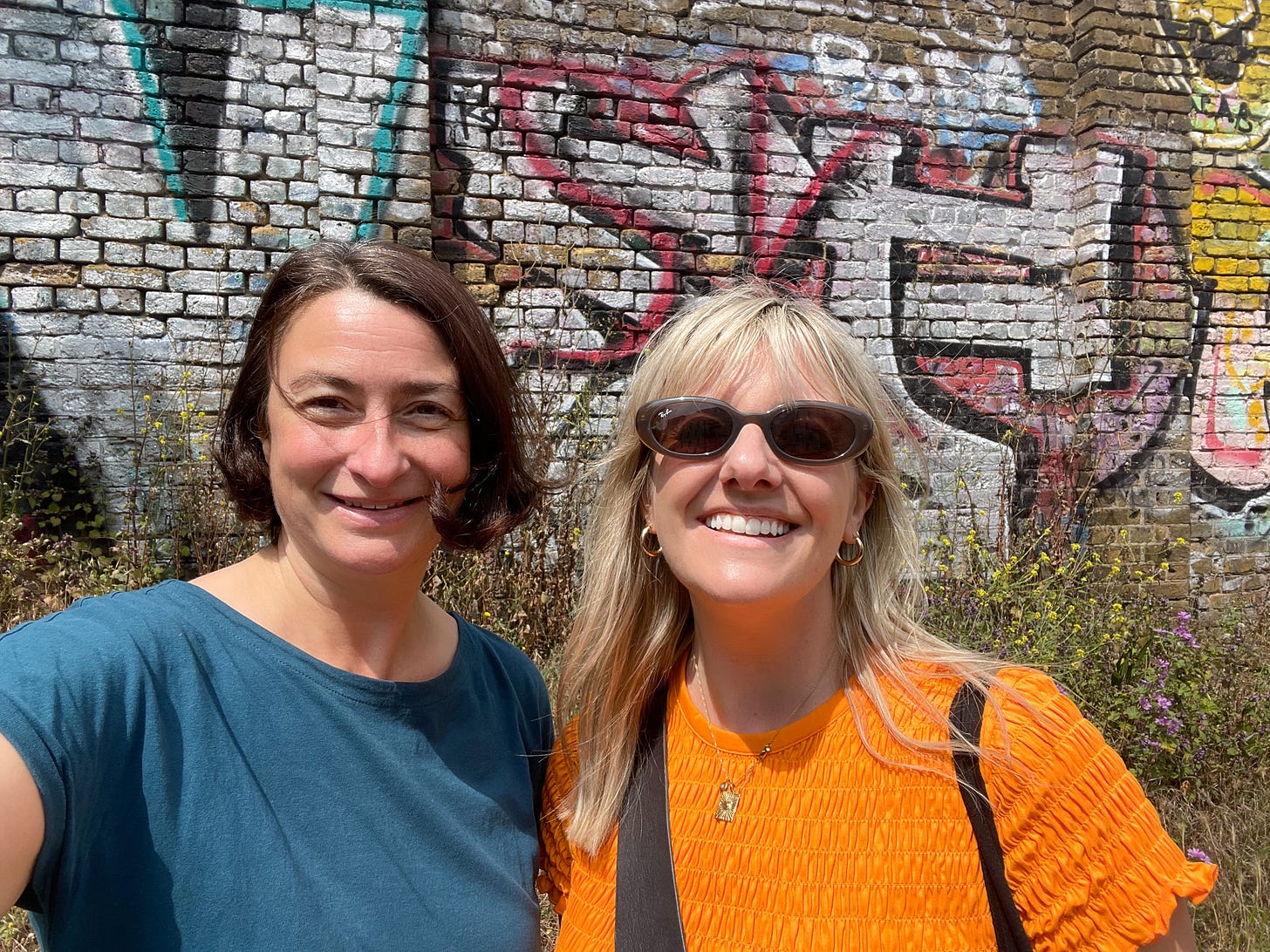
‘Everything you write is so you.’ This is such dreamy feedback, especially for a copywriter. I too focus on ‘being’ a brand every day, and run out of steam/time to be me. But I’m working on it, and this resonated. Really enjoyed this interview, thank you!
thank you so much for having me, sarah! second best walk i've ever had. <3